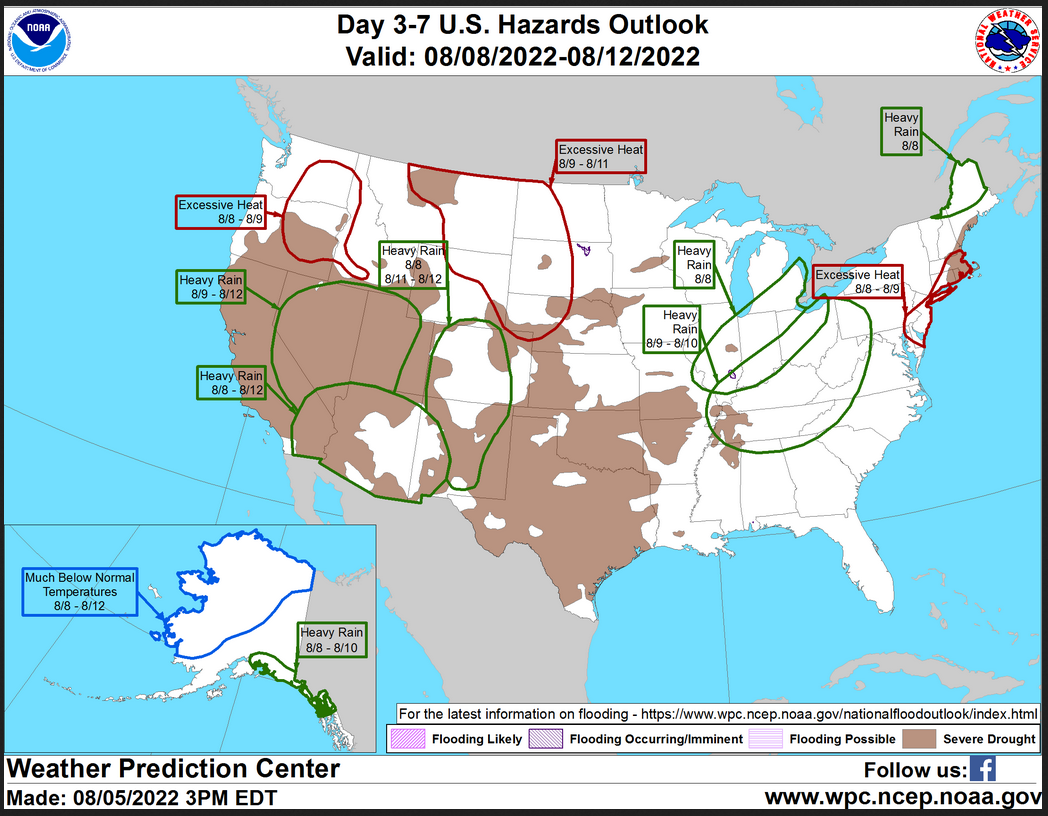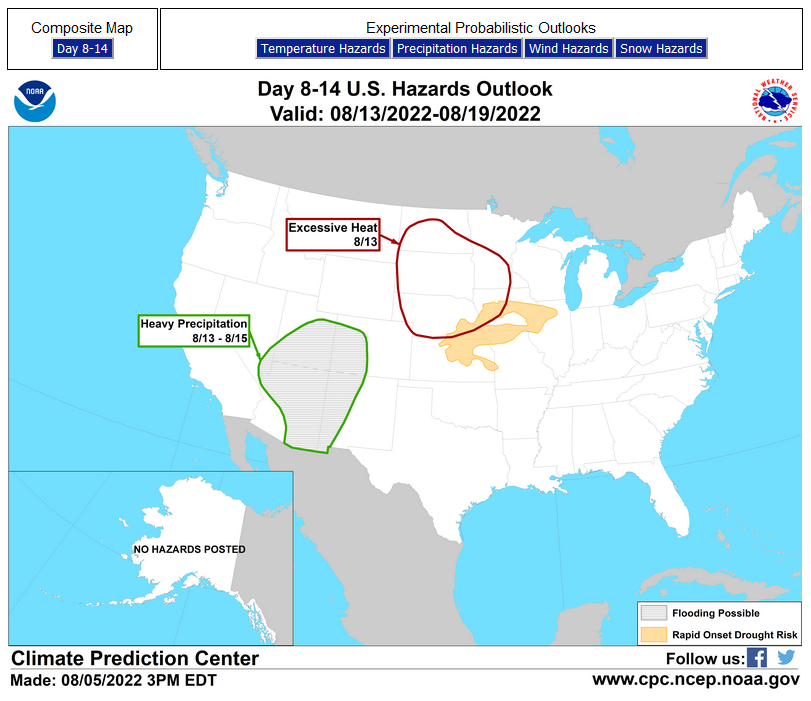Here is what we are paying attention to this evening and the next 48 hours from this evening’s NWS Forecast.
...Monsoonal rains over the western U.S. expected to shift eastward as thunderstorms ahead of a cold front could bring heavy rain into the upper Midwest on Saturday... ...Heat expected to spread across the northern tier while remaining in place over the Northeast for the next couple of days... ...Cool air spreading into the Pacific Northwest will lower the fire threat across the northern Rockies to the northern High Plains...
Continuation of the NWS Short Range Forecast (It is updated twice a day and these updates can be found here.
Cooler air will filter into the Pacific Northwest and in the Northern Plains as a cold front slowly advances over the next couple of days. Elsewhere the hot conditions are expected to stick around. To the South, southwesterly flow will transport ample Monsoonal moisture northward which will increase the possibility for showers and thunderstorms to trigger from the Great Basin to the High Plains. The advancing cold front is expected to trigger thunderstorms across the Northern Plains today before reaching into the upper Midwest on Saturday. Some of these storms may become more organized over portions of the Upper Midwest by Saturday; strong, possibly severe thunderstorms, along with areas of heavy rainfall may setup in proximity to a developing wave of surface low pressure. Meanwhile, monsoonal showers and thunderstorms will remain the rule farther south over the Great Basin and the Four Corners region with a tendency for the activities to shift eastward across the central and southern Rockies by the weekend. Over the Northern Rockies into the High Plains, monsoonal moisture drawn northward ahead of the cool air mass will be interacting with the associated front to result in some locally heavy rainfall late tonight into Saturday. A sprawling, slow moving frontal boundary across the eastern third of the county will remain the focus for convection and possibly heavy rainfall. The front is expected to lift northward toward New England as a warm front, however, scattered thunderstorms are expected to remain across much of the eastern U.S. Heat is expected to spread across the northern tier ahead of the cool air mass as high temperatures soar into the upper 90s to low 100s. Although there will be an increase in cloud cover and chances for rain that will help limit the max temperature potential, there are locations that may tie or set new daily records. The heat ahead of the cold front along with windy and dry conditions will contribute to fire concerns, particularly for parts of the West. Red Flag warnings are in effect for portions of Oregon and northern California but are expected to ease with the arrival of the cooler airmass.
Maps that relate the forecast to geography can be found by clicking Here for Day 1 and Here for Day 2.
Here is a 60-hour animated forecast map that shows how the short-term forecast is expected to play out.
If it needs to be updated click here.
HAZARDS OUTLOOKS
Click h ere for the latest complete Day 3 -7 Hazards forecast which updates only on weekdays. Once a week probably Monday or Tuesday I will update the images. I provided the link for readers to get daily updates on weekdays. Use your own judgment to decide if you need to update these images.
Worldwide Tropical Forecast
(This graphic updates on Tuesdays) If it has not been updated, you can get the update by clicking here
Detailed Maps and Reports for the Western Atlantic and the Pacific Oceans
Below are three maps that summarize the situation for the Atlantic, Eastern and Central Pacific. Additional information can be accessed by clicking HERE
First the Atlantic
Click to view the forecast map and have access to additional information https://www.nhc.noaa.gov/gtwo.php?basin=atlc&fdays=5
Then Eastern Pacific
Click to view the forecast map and have access to additional information https://www.nhc.noaa.gov/gtwo.php?basin=epac&fdays=5
Then Central Pacific
Click to view the forecast map and have access to additional information https://www.nhc.noaa.gov/gtwo.php?basin=cpac&fdays=5
And the Western Pacific
Click to view the forecast map and have access to additional information https://www.metoc.navy.mil/jtwc/jtwc.html
Some Intermediate-Term Outlooks
Links to “Outlook” maps and discussions for three time periods. Days 6 – 10, Days 8 – 14, and Weeks 3 and 4. An outlook differs from a forecast based on how NOAA uses these terms in that an “outlook” presents information from deviation from normal and the likelihood of these deviations.
You have to click on the links because they do not update automatically and I do not want to have stale images in the article. But it is not difficult to click on a link and you get a large image plus a discussion. On Fridays in a separate article, we will show the images and provide a link in this article that article. But remember what you will see is the images as of Friday. But here you can get the current images simply by clicking on them. Then hit the return arrow at the upper left of your screen to return to the article. You will not find this information easily anywhere else.
Right now you can find these maps here (We show them every Friday there but you can click above and find them).
World Forecast for Day 6 (Currently Set for Day 6 but the reader can change that)
World Weather Forecast produced by the Australian Bureau of Meteorology. Unfortunately, I do not know how to extract the control panel and embed it into my report so that you could use the tool within my report. But if you visit it Click Here and you will be able to use the tool to view temperature or many other things for THE WORLD. It can forecast out for a week. Pretty cool. Return to this report by using the “Back Arrow” usually found top left corner of your screen to the left of the URL Box. It may require hitting it a few times depending on how deep you are into the BOM tool. Below are the current worldwide precipitation and air pressure forecasts for six days out. They will not auto-update and right now are current for Day 6. If you want the forecast for a different day Click Here I will try to update this map each day but you have the link so you can access the dashboard and get a wide variety of forecasts.
I mostly rely on the reader to interpret world maps. For this map, areas of expected precipitation for the date and time shown are clearly shown.
The number of High-Pressure systems shown is called the Wave Number. Maybe I will discuss WN someday. But it shows how many Rossby Waves there are around the World. Sometimes they are hard to count. Counting Low-Pressure systems should provide the same WN. Rossby Waves are the way the temperature distribution of the Planet remains in balance. It is basically the science of fluid dynamics. It can be very helpful in predicting the movement of weather patterns.
Month to Date Information
Month to date Temperature can be found at https://hprcc.unl.edu/products/maps/acis/MonthTDeptUS.png
Month to date Precipitation can be found at https://hprcc.unl.e d u/products/maps/acis/MonthPNormUS.png







